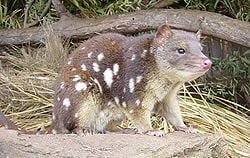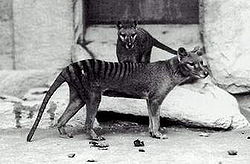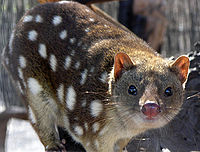Dasyuromorphia
| Dasyuromorphia
| ||||||||||||
|---|---|---|---|---|---|---|---|---|---|---|---|---|
 A quoll
| ||||||||||||
| Scientific classification | ||||||||||||
| ||||||||||||
Dasyuromorphia is an order of mammals that includes most of the Australasian carnivorous marsupials, including quolls, dunnarts, the numbat, the Tasmanian devil, and the Tasmanian wolf.
There are two extant families of dasyurmorphians, Myrmecobiidae (with one extant species, the numbat, Myrmecobius fasciatus) and Dasyuridae (with about 20 extant genera and over 70 species, including quolls, dunnarts, and the Tasmanian devil). The family of thylacines, Thylacinidae, is assumed to have gone extinct in the 20th Century with the demise of the Tasmanian wolf/Tasmanian tiger (Thylacinus cynocephalus). Dasyurmorphians are found in Australia, New Guinea, Tasmania, and some nearby islands.
Overview and description
While there is large size variation among extant members of Dasyuromorphia, the body shape tends toward uniformity. Dasyuromorphians move on four legs (quadrupedal), have pointed and generally long snouts, have long tails (Dasyuromorphia means "hairy tail"), have four toes on the front feet and four or five toes on the hind feet, and have a clawless toe on the hind feet. Dasyuromorphians have polyprotodont dentition (multiple lower incisor teeth as opposed to diprotodont dentition with two lower incisors), with four upper and three lower incisors. Members of the order Peramelemorphia (the bandicoots and bilbies) are another example of marsupials that are polyprotodont, as opposed to the diprotodont kangaroos, possums, wallabies, koala, and wombats, all of which have only two lower incisors.
Most of the carnivorous marsupials in Australia and neighboring islands are placed in Dasyuromorphia. In Australia, the exceptions include the omnivorous bandicoots (order Peramelemorphia) and the marsupial moles (which eat meat but are very different and are now accorded an order of their own, Notoryctemorphia). On the other hand, numerous South American species of marsupials (orders Didelphimorphia, Paucituberculata, and Microbiotheria) are carnivorous.
Unlike herbivores, which tend to become highly specialized for particular ecological niches and diversify greatly in form, carnivores tend to be broadly similar to one another, certainly on the level of gross external form. Just as northern hemisphere carnivores like cats, foxes, and weasels are much more alike in structure than, for example, camels, goats, pigs, and giraffes, so too are the marsupial predators constrained to retain general-purpose, look-alike forms—forms which mirror those of placental carnivores. The names given to them by early European settlers reflect this: the Thylacine was called the Tasmanian Tiger, quolls were called native cats, and so on.
The primary specialization among marsupial predators is that of size: prior to the massive environmental changes that came about with the arrival of humans about 50,000 years ago, there were several very large carnivores, none of them members of the Dasyuromorphia and all of them now extinct. Those marsupial predators among the dasyuromorphians that survived into historical times ranged from the wolf-sized Thylacine to the tiny [lLong-tailed Planigale]] which at 4 to 6 grams is less than half the size of a mouse. Most present-day dasyuromorphians, however, tend towards the lower end of the size scale, typically between about 15 or 20 grams and about 2 kilograms, or from the size of a domestic mouse to that of a small domestic cat.
Classification
To provide context, the table below also shows the other major branches of the Australasian marsupial tree.
- Order Microbiotheria: (1 species, the Monito del Monte of South America)
- ORDER DASYUROMORPHIA
- Family †Thylacinidae
- †Thylacine Thylacinus cynocephalus
- Family Dasyuridae (72 species in 20 genera)
- Subfamily Dasyurinae: quolls, Kowari, Mulgara, little red kaluta, dibblers, phascogales, antechinuses, pseudantechinuses, and the Tasmanian devil
- Subfamily Sminthopsinae: dunnarts, the Kultarr, planigales, and ningaui
- Family Myrmecobiidae
- Numbat Myrmecobius fasciatus
- Family †Thylacinidae
- Order Peramelemorphia (21 species: rainforest bandicoots, bandicoots, and bilbies)
- Order Notoryctemorphia (2 species of marsupial mole)
- Order Diprotodontia (about 137 species in 11 families, including the Koala, wombats, possums, potoroos, kangaroos, wallabies and others.)
Myrmecobiidae
- Numbat is the common name for members of the marsupial species Myrmecobius fasciatus, a diurnal, termite-eating mammal characterized by a slender body with white stripes, narrow pointed snout, small mouth with numerous small teeth, and a long, sticky tongue. Also known as the banded anteater and walpurti, M. fasciatus is found in Western Australia. It is the only extant member of its family, Myrmecobiidae.
Numbats were formerly found across southern Australia from Western Australia across as far as northwestern New South Wales. However, the range has declined significantly since the arrival of Europeans, and the species has survived only in several remnant populations in two small patches of land in the Dryandra Woodland and the Perup Nature Reserve, both in Western Australia. In recent years, it has, however, been successfully reintroduced into a few fenced reserves, including some in South Australia (Yookamurra Sanctuary) and New South Wales (Scotia Sanctuary) (Friend and Burbidge 2008)
The numbat genus Myrmecobius is the sole extant member of the family Myrmecobiidae; one of the three families that make up the order Dasyuromorphia,
The species is not closely related to other extant marsupials; the current arrangement in the dasyuromorphia order places its monotypic family with the diverse and carnivorous species of Dasyuridae. A closer affinity with the extinct thylacine has been proposed. Genetic studies have shown that the ancestors of the numbat diverged from other marsupials between 32 and 42 million years ago, during the late Eocene (Bininda-Emonds 2007).
Today, numbats are found only in areas of eucalypt forest, but they were once more widespread in other types of semi-arid woodland, Spinifex grassland, and even in terrain dominated by sand dunes (Cooper 2011).
As a marsupial, the numbat is a non-placental mammal. However, unlike most marsupials in which the females typically have an external pouch where the newborn are nursed, numbat females have no pouch. The four mammae (milk-secreating teats) are protected, however, by a patch of crimped, golden hair and by the swelling of the surrounding abdomen and thighs during lactation (Cooper 2011).
The numbat is relatively small compared to many termite-consuming mammals, with a body length of about 17.5 to 27.5 centimeters (7-11 inches) and a tail of about 13.0 to 17 centimeters (5-6.7 inches), or roughly 30 to 45 centimeters (12-17.7 inches) in total length. The adult numbat weighs from about 280 to 550 grams (0.6-1.2 pounds) (Ellis 2003).
The numbat has a finely pointed muzzle, a small mouth, and small, round-tipped ears. There are five toes on the stout forefeet, and four toes on the hindfeet; all four feet have thick and large claws (Cooper 2011; Ellis 2003). The tail is prominent and bushy. Like many termite-eating animals, the numbat has an unusually long, narrow, tongue, coated with sticky saliva produced by large submandibular glands. The tongue can reach 10. centimeters from the mouth opening (Ellis 2003). A further adaptation to the diet is the presence of numerous ridges along the soft palate, which apparently help to scrape termites off the tongue so that they can be swallowed.
Like other mammals that eat termites or ants, the numbat has a degenerate jaw with up to 50 very small non-functional teeth, and although it is able to chew (Cooper 2011), it rarely does so, because of the soft nature of its diet. Uniquely among terrestrial mammals, there is an additional cheek tooth between the premolars and molars; it is unclear whether this represents a supernumary molar tooth or a deciduous tooth retained into adult life. As a result, although not all individuals have the same dental formula, in general, it follows the unique pattern (Cooper 2011):
Thylacinidae
| Thylacinids
| ||||||||||||
|---|---|---|---|---|---|---|---|---|---|---|---|---|
 Thylacine
| ||||||||||||
| Scientific classification | ||||||||||||
| ||||||||||||
|
All extinct, see text |
Thylacinidae is an extinct family of carnivorous, superficially dog-like marsupials from the order Dasyuromorphia. The only species to survive into modern times was the Thylacine (Thylacinus cynocephalus), which became extinct in 1936. All other thylacinids all lived in prehistoric times in Australia.
Species
Family †Thylacinidae
- Genus †Badjcinus
- †Badjcinus turnbulli (Early Oligocene)
- Genus †Maximucinus
- †Maximucinus muirheadae (Middle Miocene)
- Genus †Muribacinus
- †Muribacinus gadiyuli (Middle Miocene)
- Genus †Mutpuracinus
- †Mutpuracinus archiboldi (Middle Miocene)
- Genus †Ngamalacinus
- †Ngamalacinus timmulvaneyi (Early Miocene)
- Genus †Nimbacinus
- Genus †Thylacinus
- Genus †Tjarrpecinus
- †Tjarrpecinus rothi (Late Miocene)
- Genus †Wabulacinus
Dasyuridae
| Dasyurids[1] | ||||||||||||
|---|---|---|---|---|---|---|---|---|---|---|---|---|
 Tiger quoll
| ||||||||||||
| Scientific classification | ||||||||||||
| ||||||||||||
|
Dasyurinae
Sminthopsinae
|
The Dasyuridae are a family of marsupials native to Australia and New Guinea, including 75 species divided into 15 genera.[1] Many are small and mouse-like, giving them the misnomer marsupial mice, but the group also includes the cat-sized quolls, as well as the Tasmanian devil. They are found in a wide range of habitats, including grassland, forests, and mountains, and some species are arboreal or semiaquatic.
Characteristics
Most dasyurids are roughly the size of mice, but a few species are much larger. The smallest species is the Pilbara ningaui, which is from 4.6 to 5.7 cm in length, and weighs just 2–9 grams, while the largest, the Tasmanian devil, is 57–65 cm long, and weighs from 6–8 kg. The smaller dasyurids typically resemble shrews or mice in appearance, with long tails and narrow, pointed noses. The larger species bear a resemblance to such placental carnivores as mongooses or mustelids.[2]
Many features of dasyurids are considered primitive, that is, they resemble the features of the earliest marsupials, from which other species, such as kangaroos and bandicoots, later diverged. For example, all of the toes in dasyurids are separate, whereas in many other marsupials, the second and third toes are fused. Similarly, many species lack a full marsupial pouch, instead they have a simple fold of skin surrounding the teats to provide some protection to the developing young. The dentition of dasyurids is also considered primitive, and differs from that of other marsupials, with a dental formula of: .
Dasyurids are primarily insectivorous, but they will also eat small lizards, fruit, and flowers. One of the few exceptions to this rule is the Tasmanian devil, which subsists mainly on vertebrate carrion.[2] They have relatively simple digestive tracts, as is typical of insectivores and carnivores.
Gestation lasts from 12–16 days, and results in the birth of from two to 12 young, depending on species. Smaller species typically breed at least twice a year, while the larger forms tend to breed just once. The length of lactation reflects this, with young dunnarts, for example, being weaned after 60–70 days, but young quolls only after 8–9 months. Most dasyurid species are sexually mature at one year of age, but, again, the quolls and Tasmanian devil, being larger, take longer to mature and do not reach full adulthood for about two years.[2]
Adult dasyurids are typically solitary, or travel in small groups of two to three individuals.
Classification
- Family Dasyuridae
- Genus Ganbulanyi (fossil)
- Genus Glaucodon (fossil)
- Subfamily Barinyainae (fossil)
- Genus Barinya (fossil)
- Subfamily Dasyurinae
- Tribe Dasyurini
- Genus Dasycercus
- Brush-tailed mulgara, Dasycercus blythi
- Crest-tailed mulgara, Dasycercus cristicauda
- Genus Dasykaluta
- Little red kaluta, Dasykaluta rosamondae
- Genus Dasyuroides
- Kowari, Dasyuroides byrnei
- Genus Dasyurus: quolls
- New Guinean quoll, Dasyurus albopunctatus
- Western quoll, Dasyurus geoffroii
- Northern quoll, Dasyurus hallucatus
- Tiger quoll, Dasyurus maculatus
- Bronze quoll, Dasyurus spartacus
- Eastern quoll, Dasyurus viverrinus
- Genus Myoictis
- Woolley's three-striped dasyure, Myoictis leucera
- Three-striped dasyure, Myoictis melas
- Wallace's dasyure, Myoictis wallacii
- Tate's three-striped dasyure, Myoictis wavicus
- Genus Neophascogale
- Speckled dasyure, Neophascogale lorentzi
- Genus Parantechinus
- Dibbler, Parantechinus apicalis
- Genus Phascolosorex
- Phascolosorex brevicaudata
- Red-bellied marsupial shrew, Phascolosorex doriae
- Narrow-striped marsupial shrew, Phascolosorex dorsalis
- Genus Pseudantechinus
- Sandstone dibbler, Pseudantechinus bilarni
- Fat-tailed false antechinus, Pseudantechinus macdonnellensis
- Alexandria false antechinus, Pseudantechinus mimulus
- Ningbing false antechinus, Pseudantechinus ningbing
- Rory Cooper's false antechinus, Pseudantechinus roryi
- Woolley's false antechinus, Pseudantechinus woolleyae
- Genus Sarcophilus
- Tasmanian devil, Sarcophilus harrisii
- Genus Dasycercus
- Tribe Phascogalini
- Genus Antechinus
- Tropical antechinus, Antechinus adustus
- Agile antechinus, Antechinus agilis
- Fawn antechinus, Antechinus bellus
- Yellow-footed antechinus, Antechinus flavipes
- Atherton antechinus, Antechinus godmani
- Cinnamon antechinus, Antechinus leo
- Swamp antechinus, Antechinus minimus
- Brown antechinus, Antechinus stuartii
- Subtropical antechinus, Antechinus subtropicus
- Dusky antechinus, Antechinus swainsonii
- Genus Micromurexia
- Habbema dasyure, Micromurexia habbema
- Micromurexia hageni
- Genus Murexechinus
- Black-tailed dasyure, Murexechinus melanurus
- Genus Murexia
- Short-furred dasyure, Murexia longicaudata
- Genus Paramurexia
- Broad-striped dasyure, Paramurexia rothschildi
- Genus Phascomurexia
- Long-nosed dasyure, Phascomurexia naso
- Genus Phascogale
- Red-tailed phascogale, Phascogale calura
- Phascogale pirata
- Brush-tailed phascogale, Phascogale tapoatafa
- Genus Antechinus
- Tribe Dasyurini
- Subfamily Sminthopsinae
- Tribe Sminthopsini
- Genus Antechinomys
- Kultarr, Antechinomys laniger
- Genus Ningaui
- Wongai ningaui, Ningaui ridei
- Pilbara ningaui, Ningaui timealeyi
- Southern ningaui, Ningaui yvonnae
- Genus Sminthopsis
- †S. floravillensis Archer, 1982
- S. crassicaudata species-group
- Fat-tailed dunnart, Sminthopsis crassicaudata
- S. macroura species-group
- Kakadu dunnart, Sminthopsis bindi
- Carpentarian dunnart, Sminthopsis butleri
- Julia Creek dunnart, Sminthopsis douglasi
- Stripe-faced dunnart, Sminthopsis macroura
- Red-cheeked dunnart, Sminthopsis virginiae
- S. granulipes species-group
- White-tailed dunnart, Sminthopsis granulipes
- S. griseoventer species-group
- Kangaroo Island dunnart, Sminthopsis aitkeni
- Boullanger Island dunnart, Sminthopsis boullangerensis
- Grey-bellied dunnart, Sminthopsis griseoventer
- S. longicaudata species-group
- Long-tailed dunnart, Sminthopsis longicaudata
- S. murina species-group
- Chestnut dunnart, Sminthopsis archeri
- Little long-tailed dunnart, Sminthopsis dolichura
- Sooty dunnart, Sminthopsis fulginosus
- Gilbert's dunnart, Sminthopsis gilberti
- White-footed dunnart, Sminthopsis leucopus
- Slender-tailed dunnart, Sminthopsis murina
- S. psammophila species-group
- Hairy-footed dunnart, Sminthopsis hirtipes
- Ooldea dunnart, Sminthopsis ooldea
- Sandhill dunnart, Sminthopsis psammophila
- Lesser hairy-footed dunnart, Sminthopsis youngsoni
- Genus Antechinomys
- Tribe Planigalini
- Genus Planigale
- Paucident planigale, Planigale gilesi
- Long-tailed planigale, Planigale ingrami
- Common planigale, Planigale maculata
- New Guinean planigale, Planigale novaeguineae
- Narrow-nosed planigale, Planigale tenuirostris
- Genus Planigale
- Tribe Sminthopsini
External links
- Prehistoric range of the Thylacinidae
- Australian Thylacine
- Various Links
- Mikko's Phylogeny Archive
- The thylacine journey
- Maximucinus, Stephen Wroe 2001
ReferencesISBN links support NWE through referral fees
- ↑ 1.0 1.1 C. Groves, "Order Primates," "Order Monotremata," (and select other orders). Page(s) 23–37 in D. E. Wilson and D. M. Reeder, eds., Mammal Species of the World, 3rd edition, Johns Hopkins University Press (2005). ISBN 0801882214.
- ↑ 2.0 2.1 2.2 Lee, A.K. (1984). in Macdonald, D.: The Encyclopedia of Mammals. New York: Facts on File, 838–845. ISBN 0-87196-871-1.
- C. Groves, "Order Primates," "Order Monotremata," (and select other orders). Page(s) 23-37 in D. E. Wilson and D. M. Reeder, eds., Mammal Species of the World, 3rd edition, Johns Hopkins University Press (2005). ISBN 0801882214.
- Bininda-Emonds, O. R. P. 2007. The delayed rise of present-day mammals. Nature 446: 507–512. PMID 17392779.
- Cooper, C. E. 2011. Myrmecobius fasciatus (Dasyuromorphia: Myrmecobiidae). Mammalian Species 43(1): 129–140.
- Cooper, C. E., and P. C. Withers. 2004. Patterns of body temperature variation and torpor in the numbat, Myrmecobius fasciatus (Marsupialia: Myrmecobiidae). Journal of Thermal Biology 29(6): 277–284.
- Cooper, C. E., and P. C. Withers. 2010. Gross renal morphology of the numbat (Myrmecobius fasciatus) (Marsupialia : Myrmecobiidae). Australian Mammalogy 32(2): 95–97.
- Ellis, E. 2003. Myrmecobius fasciatus. Animal Diversity Web. Retrieved March 19, 2012.
- Wilson, D. E., and D. M. Reeder (eds.). 2005. [http://www.bucknell.edu/msw3/browse.asp?id=10800007 Mammal Species of the World (3rd ed.). Baltimore: Johns Hopkins University. ISBN 9780801882210.
Chad Nihranz and Elizabeth Colvin, N. 2013. Dasyuromorphia. University of Michigan-Ann Arbor: Animal Diversity Web. Retrieved May 08, 2014.
Myers, P. 2001. "Dasyuridae" (On-line), Animal Diversity Web. Accessed May 08, 2014 at http://animaldiversity.ummz.umich.edu/accounts/Dasyuridae/
Myers, P. 2001. "Myrmecobiidae" (On-line), Animal Diversity Web. Accessed May 08, 2014 at http://animaldiversity.ummz.umich.edu/accounts/Myrmecobiidae/
Myers, P. 2001. "Thylacinidae" (On-line), Animal Diversity Web. Accessed May 08, 2014 at http://animaldiversity.ummz.umich.edu/accounts/Thylacinidae
External links
- Dasyuromorphia on Animal Diversity Web
| Mammals |
|---|
| Monotremata (platypus, echidnas) |
|
Marsupialia: | Paucituberculata (shrew opossums) | Didelphimorphia (opossums) | Microbiotheria | Notoryctemorphia (marsupial moles) | Dasyuromorphia (quolls and dunnarts) | Peramelemorphia (bilbies, bandicoots) | Diprotodontia (kangaroos and relatives) |
|
Placentalia: Cingulata (armadillos) | Pilosa (anteaters, sloths) | Afrosoricida (tenrecs, golden moles) | Macroscelidea (elephant shrews) | Tubulidentata (aardvark) | Hyracoidea (hyraxes) | Proboscidea (elephants) | Sirenia (dugongs, manatees) | Soricomorpha (shrews, moles) | Erinaceomorpha (hedgehogs and relatives) Chiroptera (bats) | Pholidota (pangolins)| Carnivora | Perissodactyla (odd-toed ungulates) | Artiodactyla (even-toed ungulates) | Cetacea (whales, dolphins) | Rodentia (rodents) | Lagomorpha (rabbits and relatives) | Scandentia (treeshrews) | Dermoptera (colugos) | Primates | |
Template:Dasyuromorphia
Credits
New World Encyclopedia writers and editors rewrote and completed the Wikipedia article in accordance with New World Encyclopedia standards. This article abides by terms of the Creative Commons CC-by-sa 3.0 License (CC-by-sa), which may be used and disseminated with proper attribution. Credit is due under the terms of this license that can reference both the New World Encyclopedia contributors and the selfless volunteer contributors of the Wikimedia Foundation. To cite this article click here for a list of acceptable citing formats.The history of earlier contributions by wikipedians is accessible to researchers here:
The history of this article since it was imported to New World Encyclopedia:
Note: Some restrictions may apply to use of individual images which are separately licensed.


